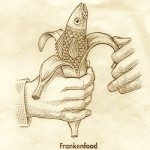by Catherine Haug, Nov 2015 (Image, right, from Organic Consumers Assoc., used with permission)
The latest GMO foods to be approved by the USDA/FDA include:
- Russet potato ‘Innate’ (for baking or deep frying) from J.R. Simplot Co. approved by USDA without mandatory labeling.
- AquAdvantage farmed Salmon developed by Aqua Bounty Technologies, approved by FDA who recommended, but did not require, labeling of these fish as GMO.
For more information about the GMO salmon and efforts to fight back and mandate GMO labeling on GMO fish, see the Center for Food Safety’s site: centerforfoodsafety.org/issues/309/ge-fish. They are considering suing the FDA over this approval without mandatory labeling.





